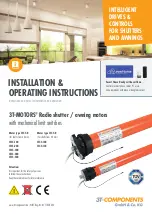
Assembly Instruction
Configuration
Torque Motor
TM-Komponenten-04-0-EN-2108-MA
Page 29 of 84
3.5
Water cooling system calculation
The features of motor indicated in HIWIN torque motor drawing and specification are suitable for water cooling
condition, and coolant temperature is 20
℃
. Taking oil as coolant is also acceptable. Just properly modify the
performance of motor based on the features of coolant. The cooling condition indicated in specification: coil
temperature should be less than 120
℃
(130
℃
for
□
M-2) when motor stator continuously operates under
continuous torque. If equivalent torque of actual operation is lower than continuous torque indicated in
specification, reduce cooling water flow to avoid consuming excess pump. The cooling condition can be properly
adjusted based on the following formulas.
Adjust the boundary conditions of water cooling system according to the motor power loss:
When equivalent torque is lower than continuous torque (
T
e
< T
c
), get the corresponding coolant flow from the
following formulas.
P
e
=
p
c
�
T
c
T
e
�
2
P
e
= 69.7
∙
q
e
∙ ∆θ
P
e
= Total loss of motor under equivalent torque [
W
]
∆θ
= Temperature difference between motor inlet and outlet [
℃
]
q
e
= Coolant flow
[l/min]
(under equivalent torque)
Pressure difference between inlet and outlet (
∆
P
eff
) is related to coolant flow (
q
)
∆
P
eff
=
∆
P
∙
q
e
q
∆
P
eff
= Pressure difference between inlet and outlet [
bar
] (under equivalent torque)
∆
P
= Pressure difference between inlet and outlet [
bar
] (in datasheet)
q
= Coolant flow [
l/min
] (n datasheet)
Example
In model type TMRWAF’s specification, the continuous torque (
T
c
) water cooling condition is 1.290 Nm, power
loss (
P
c
) is 8.262 W, coolant flow (
q
) is 23,7 l/min, pressure difference between inlet and outlet (
∆
P
) is 3 bar. If
the used continuous toque is only 600 Nm
and the temperature difference between inlet and outlet should be
6
℃
, what is the coolant flow (
q
e
) and the pressure difference between inlet and outlet (
∆
P
eff
) in cooling
water system?
[
v
water
= 10
−3
(m
3
/kg)
]
P
e
=
p
c
�
T
c
T
e
�
2
=
8262
�
1290
600
�
2
= 1787(W)
1787 = 69,7 × q
e
× 6
q
e
= 4.27(l/min)
∆
P
eff
=
∆
P
∙
q
e
q = 3 ×
4,27
23,7 = 0.54(bar)
The differences between datasheet parameters and user parameters are listed in the following Table 3.1.
















































